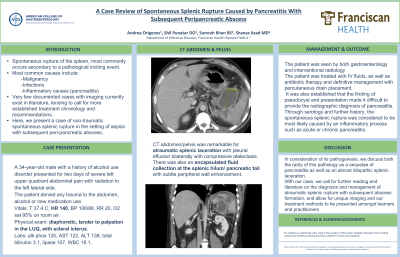Back

Poster Session B - Monday Morning
Category: Biliary/Pancreas
B0070 - A Case Review of Spontaneous Splenic Rupture Caused by Pancreatitis With Subsequent Peripancreatic Abscess
Monday, October 24, 2022
10:00 AM – 12:00 PM ET
Location: Crown Ballroom


Shil Punatar, DO
Franciscan Health Olympia Fields
Schaumburg, IL
Presenting Author(s)
Andrea Kristin Origenes, 1, Shil Punatar, DO2, Sumrah Khan, 1, Shanaz Azad, MD2
1Midwestern University, Downers Grove, IL; 2Franciscan Health Olympia Fields, Olympia Fields, IL
Introduction: Spontaneous rupture of the spleen, a rare presentation, most commonly occurs secondary to a pathological inciting event. Most common causes include malignancy, infections, or inflammatory causes such as pancreatitis. Very few documented cases with imaging currently exist in literature, lending to call for more established treatment chronology and recommendations. Here, we present a case of non-traumatic spontaneous splenic rupture in the setting of sepsis with subsequent peri-pancreatic abscess.
Case Description/Methods: A 34-year-old male with a history of alcohol use disorder presented for two days of severe left upper quadrant abdominal pain with radiation to the left lateral side. His vitals included T 37.4 C, HR 140, BP 106/86, RR 20, O2 sat 95% on room air. The patient was diaphoretic, tender to palpation in the LUQ, with scleral icterus. Labs were significant for alk phos 125, AST 122, ALT 138, total bilirubin 3.1, lipase 107. CBC demonstrated WBC 18.1. CT abdomen/pelvis was remarkable for atraumatic splenic laceration with pleural effusion bilaterally with compressive atelectasis. CT imaging demonstrated an encapsulated fluid collection at the splenic hilum/ pancreatic tail with subtle peripheral wall enhancement. These findings may represent a walled off pancreatic pseudocyst, organized hematoma or possibly abscess. After interdisciplinary discussion, the patient was seen by both gastroenterology and interventional radiology with decision made to treat the patient with IV fluids, as well as antibiotic therapy and definitive management with percutaneous drain placement. It was also established that the finding of pseudocyst and presentation made it difficult to provide the radiographic diagnosis of pancreatitis. Through serology and further history, the spontaneous splenic rupture was considered to be most likely caused by an inflammatory process such as acute or chronic pancreatitis.
Discussion: With this case, we demonstrate the presentation of peri-pancreatic abscess, which is a diagnosis that is unique within itself. In consideration of its pathogenesis, we discuss both the rarity of this pathology as a sequelae of pancreatitis as well as an almost idiopathic splenic laceration. With our case, we call for further reading and literature on the diagnosis and management of atraumatic splenic rupture with subsequent abscess formation, and allow for unique imaging and our treatment methods to be presented amongst learners and practitioners.
Disclosures:
Andrea Kristin Origenes, 1, Shil Punatar, DO2, Sumrah Khan, 1, Shanaz Azad, MD2. B0070 - A Case Review of Spontaneous Splenic Rupture Caused by Pancreatitis With Subsequent Peripancreatic Abscess, ACG 2022 Annual Scientific Meeting Abstracts. Charlotte, NC: American College of Gastroenterology.
1Midwestern University, Downers Grove, IL; 2Franciscan Health Olympia Fields, Olympia Fields, IL
Introduction: Spontaneous rupture of the spleen, a rare presentation, most commonly occurs secondary to a pathological inciting event. Most common causes include malignancy, infections, or inflammatory causes such as pancreatitis. Very few documented cases with imaging currently exist in literature, lending to call for more established treatment chronology and recommendations. Here, we present a case of non-traumatic spontaneous splenic rupture in the setting of sepsis with subsequent peri-pancreatic abscess.
Case Description/Methods: A 34-year-old male with a history of alcohol use disorder presented for two days of severe left upper quadrant abdominal pain with radiation to the left lateral side. His vitals included T 37.4 C, HR 140, BP 106/86, RR 20, O2 sat 95% on room air. The patient was diaphoretic, tender to palpation in the LUQ, with scleral icterus. Labs were significant for alk phos 125, AST 122, ALT 138, total bilirubin 3.1, lipase 107. CBC demonstrated WBC 18.1. CT abdomen/pelvis was remarkable for atraumatic splenic laceration with pleural effusion bilaterally with compressive atelectasis. CT imaging demonstrated an encapsulated fluid collection at the splenic hilum/ pancreatic tail with subtle peripheral wall enhancement. These findings may represent a walled off pancreatic pseudocyst, organized hematoma or possibly abscess. After interdisciplinary discussion, the patient was seen by both gastroenterology and interventional radiology with decision made to treat the patient with IV fluids, as well as antibiotic therapy and definitive management with percutaneous drain placement. It was also established that the finding of pseudocyst and presentation made it difficult to provide the radiographic diagnosis of pancreatitis. Through serology and further history, the spontaneous splenic rupture was considered to be most likely caused by an inflammatory process such as acute or chronic pancreatitis.
Discussion: With this case, we demonstrate the presentation of peri-pancreatic abscess, which is a diagnosis that is unique within itself. In consideration of its pathogenesis, we discuss both the rarity of this pathology as a sequelae of pancreatitis as well as an almost idiopathic splenic laceration. With our case, we call for further reading and literature on the diagnosis and management of atraumatic splenic rupture with subsequent abscess formation, and allow for unique imaging and our treatment methods to be presented amongst learners and practitioners.
Disclosures:
Andrea Kristin Origenes indicated no relevant financial relationships.
Shil Punatar indicated no relevant financial relationships.
Sumrah Khan indicated no relevant financial relationships.
Shanaz Azad indicated no relevant financial relationships.
Andrea Kristin Origenes, 1, Shil Punatar, DO2, Sumrah Khan, 1, Shanaz Azad, MD2. B0070 - A Case Review of Spontaneous Splenic Rupture Caused by Pancreatitis With Subsequent Peripancreatic Abscess, ACG 2022 Annual Scientific Meeting Abstracts. Charlotte, NC: American College of Gastroenterology.
